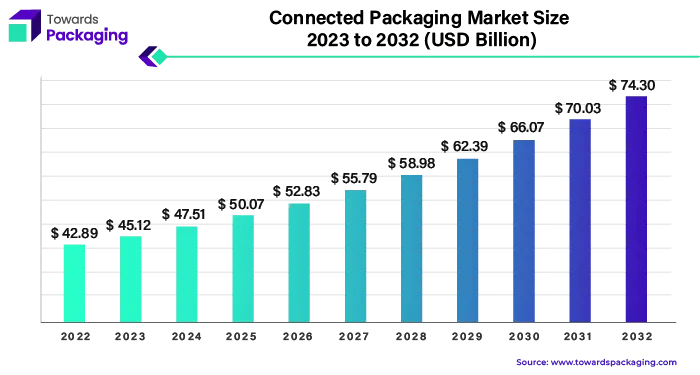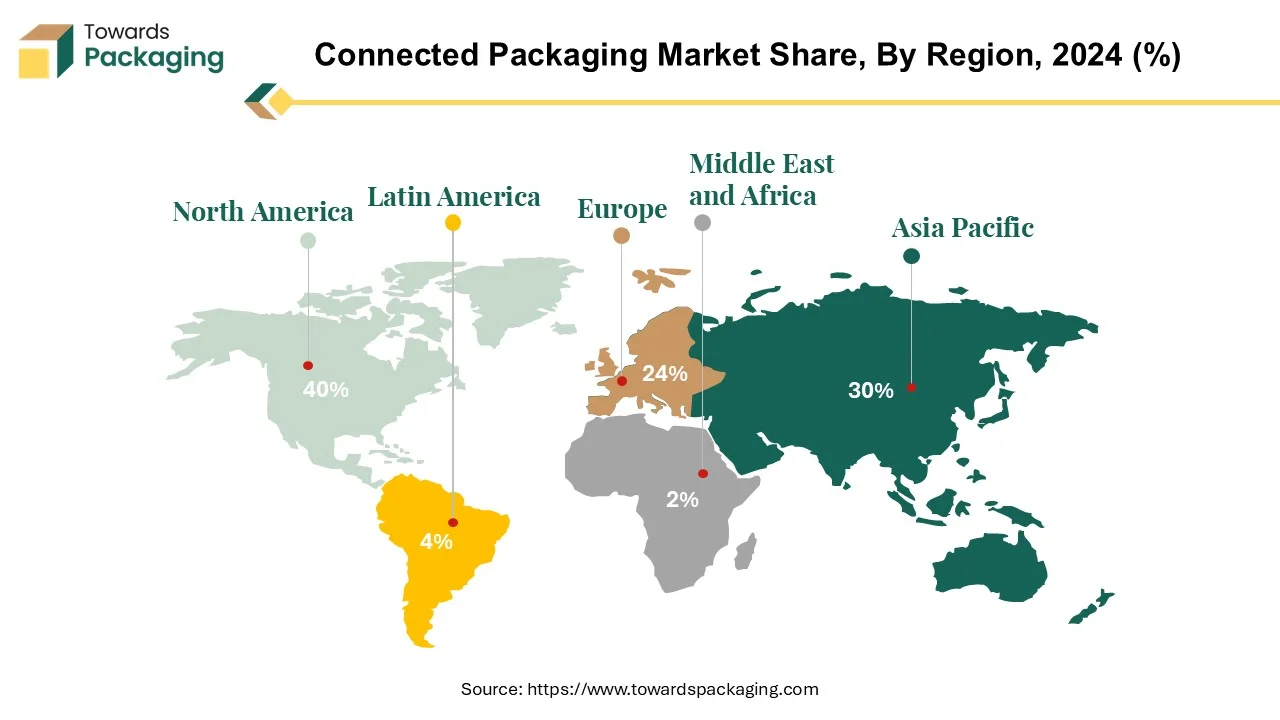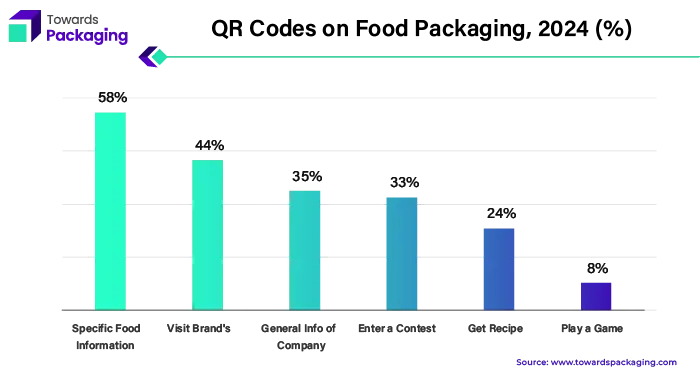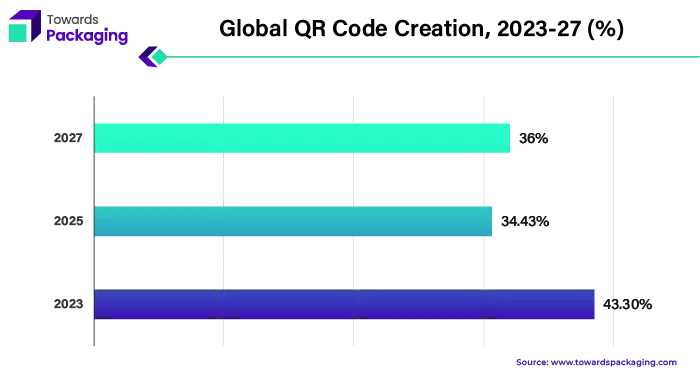April 2025
The connected packaging market is anticipated to grow from USD 50.41 billion in 2025 to USD 83.02 billion by 2034, with a compound annual growth rate (CAGR) of 5.7% during the forecast period from 2025 to 2034.

Connected packaging market is growing with the aim of filling the blanks in digitally and physically spaced areas. Probably one of the most difficult examples is integration of QR codes on product packaging. RFID, NFC are other connecting technologies which are widely integrated into packaging. These codes may be scanned by the customer's smartphone camera and it will redirect them to online subjects. The consumer the manufacturer’s website, to know more on the product and company, or if it is the user manual, direct him / her to a specific product page. Intelligent packaging is a fast-developing area that targets big brands mostly, creating new shopping experiences by combining animated gaming, music and sensory imaging with traditional packaging features.
This technique adheres to the concept of customer choice theory, that argues that clients look for products and services that are tailor-made to fit their individual needs. Personalization is a proclamation that the company is thinking about customer’s uniqueness, a factor that improves their image and encourages customer loyalty.
The connected packaging is done by making results based upon the user who has scanned the QR code and it is a mode of personalization. If a citizen in a Spanish speaking country scans a QR code on a US manufactured product, they will be guided to the Spanish version of the website. During this process, the technology provider employs customer's geo-location data and his/her device's setting information, which in turn helps the customers receive pertinent products and customer support platforms.
The growth of e-commerce, mainly with the pandemic as a background, has added an additional impulse to the consumer-packaged goods that are made to be connected. The figure e-commerce growth has stabilized a bit more, the jump in online sales was 7.8% in the first quarter of 2023, which was completed by the US Census Bureau. Industries including such as F&B, Pharma and Medical Support Systems/Equipment, and Consumer Packaged Goods have come to realize the big role that packaging in the increasingly tech-reliant, omni-channel economy, has recently acquired.
Companies are using connected packaging to intensify their approach to sustainability issues; as technology advancement, results in the ability to detect private labelled packaging with accuracy as high as 99%. This is one method through which this technology can be made available to consumers with interactive features attractive to the end-user and directly addressing consumer recycling concerns by cloud-based data from the watermarks.
For Instance,

The North American market for connected packaging is undergoing major growth, which may be attributed to several key factors. An increasing percentage of the shopping population is always looking for the newest and the most enticing. Digital packaging is perfect for satisfying this need as they do a great job by fusing the online and walk the talk worlds, letting customers dig into online content with a push of a button on the packaging. The growth of the e-commerce sales in North America makes connected packaging adoption to take-off. Increasingly more shoppers shop online, brands thus are looking for advanced novel means to reach the customers of theirs beyond the only bordered of retail stores.

The utilisation of QR codes and interactive features on packaging such as product information, promotions or personalized experiences will bring online shoppers an additional benefit. it is the US in the lead with the number of QR Code scans accounting 25 million globally. According to statistics from a trusted source, this figure rose to a 74.78% share of the total scans by 2022, making up 38 million scans from the top 50 countries. This information shows the great share of American citizens who actively use the technology of QR-Codes and speak the good trend as well.
North American industries covering Sub-Sectors like Food & Beverage, Pharma, Medical Supplies or Devices, and Consumer Packaged Goods are adapting packaging to the consumer experience enhancement. North American manufacturers making headway on sustainable projects. The connected packaging provides an avenue to scale down on waste as well as to optimize recycling initiatives. With the use of technologies like tagging watermarks and the Internet of Things, brands can inform buyers the life of packaging materials by cloud data collection and also provide consumers with recycling information directly through connected packaging. North American connected packaging has a favourable condition, as consumers need interactive experiences, growth of e-commerce, industries wanting to innovate on packaging, and sustainability in focus. These factors are providing sufficient motivation for on-going investment and the creation of new connected packaging products within this region.
Asia Pacific is the centre where the emergence of the new and innovations are often first tested. Nations such as Korea, Japan, and China have come to the forefront of this technology’s implementation, placing QR codes on the packaging to promote their convenience. QR codes play a game changer role in digital marketing toolbox, converting consumers to engage with a physical display by scanning a QR to explore the extent of information collection.
A very important reason for this situation is the trend of putting transparency and reliability in forefront of consumers' relationship with the producer. The smart packaging and product labels are spurring with QR codes, which allow the consumers to discover useful information about the product’s journey such as the field where it was grown, how it was made, its logistics, transportation routes, as well as the ingredients included. This transparency in particular helps build the consumers trust, assuring them that the goods they buy actually correspond to specified quality and authenticity standards.
Asia Pacific market has been through an incredible QR code for packaging growing, and it is believed that the growth is to jump 83% in the coming year. The region applies such exponential growth in the adoption of new technologies that are not only designed with an eye to provide better service and meet the needs of varied consumers. In China, C2C (QR codes) have became inseparable for consumers with 65% of them deeming them optimal wise to achieve credibility. This wide spread acceptance of these codes calls the attention to the crucial influence of QR codes on building credibility and earning customers' trust playing a much more important role in a highly competitive commerce.
Asia Pacific region is the world’s leading region in packaging innovation to relate well with increasing trend. This region will undoubtedly shape the future of the global consumer engaged and brand experience. In light of its various colourful marketplaces, technology-based consumers and leading fields, Asia-Pacific sets the pace for change to prevail in the packaging business.
For Instance,
Packaging has gone through a remarkable change shape from time to time. Initially, it served as just a product protection strategy, but later on, it transformed into the primary look of a brand. When connected packaging technologies have been introduced, it becomes more than a package’s visual element and into an important part of the brand narratives. In the contemporary competitive market-place visual appeal is very important in grabbing the consumers’ interest with the main challenge being beyond repetitive customers. Unique and eye-catching design for packaging and labels beautifully contribute to the general style of your product on a shelf by attracting customers to search more. Next on the line is connected packaging which through QR codes reappear or rather explore more alternatives of the physical and the digital world.
The ubiquity of QR codes is beyond anything we have ever witnessed. By the end of 2022, it is estimated that at least 5.3 billion QR codes will be employed for coupon redemption, one of the main applications. These codes allow consumers to rapidly connect with brands hence proving crucial in providing access to product information, while on the other hand, brands can also easily gain feedback from their consumers.
Packaging is the final means of communication between a consumer and a brand whereby consumers expect to get detailed product information from many aspects such as allergens, ingestion, usage, and recycling instructions. It also serves as a critical completion point to develop an enduring bond with consumers for the brands.
The current customers make business sales of the company more than half now i.e. they account for about 60%. Noteworthy is the fact that only an 5% improvement in customer retention can lead to major increases in profits ranging from 25% to 95%. This gives an insight into the need of the packaging for the education and engagement of the customers in addition to the creation of eternity as regards the brand loyalty and prosperity.
For Instance,

A food and beverage marketing firm has paid much attention to the increasing movement of connected packaging, which deftly links digital marketing and branded food packaging together. Such a conjunction of technology and package design creates connected packaging that enables the packaging to convert from a traditional food one into marketing tool. With nowadays widespread use of smartphones, food brands can capitalize on that fact and employ connected packaging as a way to interact with their consumers.
Packaging, which is probably the most important marketing tool, plays double duties in placing a brand in the right spot at a point of purchase, as it also contains the necessary information about the product and nutrients Incorporating technologies like QR codes, near-field communication (NFC) tags, and augmented reality (AR) markers into packaging, the latter can become even more multifunctional.
These digital components when a consumer scans or interacts with them by using their smartphones become a whole range of digital experiences. This could involve offering full product details and active stories in addition to fully integrated brand experience. Fundamentally, connected packaging volunteers an additional medium through which food brands can powerfully communicate and engage consumers in the digital age of today.
For Instance,
E-commerce marketing arguably is one of the most significant drivers in the development of intelligent and interactive packaging. Along with the growing popularity of online shopping, brands are more and more begun to use connected packaging to improve digital shopping as well.

Through the introduction of technologies such as QR codes, near-field communication (NFC) tags, and AR markers onto product packaging, brands can easily link the offline and online environments via Omni-channel marketing. Millions of QR codes are created every day, and as a result, businesses all over the world are able to use these flexible tools to facilitate smooth digital interactions between customers and brands.
Internet-connected packaging gives access to the consumer for a plethora of data and interactive information directly from their smartphones. This touches upon features like product descriptions, user manuals, customer reviews, and even a brand that you might want to experience immersivity. The connectivity of the packaging offers e-commerce a competitive advantage via delightful consumer to product interaction and extra service provision.
Through connected packaging, brands can capture consumer interaction achievements and gather marketing relevant data insights, thus giving them ability to create customized marketing strategies and improve people’s experience. In the fast-paced online shopping world, where consumers’ attention is highly distracted and competition is extremely intensive, connected packages seem to be a promising approach for companies to stand out and strengthen the bonds with online shoppers.
For Instance,
The competitive landscape of the connected packaging market is dominated by established industry giants such as Amcor plc, 3M, Stora Enso, Thin Film Electronics ASA, Huhtamaki Oyj, Constantia Flexibles, R.R. Donnelley & Sons Company, BALL CORPORATION, Klöckner Pentaplast, Graham Packaging Company, Avery Dennison Corporation, Emerson Electric Co, American Thermal Instruments, BASF SE, and International Paper. These giants compete with upstart direct-to-consumer firms that use digital platforms to gain market share. Key competitive characteristics include product innovation, sustainable practices, and the ability to respond to changing consumer tastes.
Amcor is committed to using smart packaging technology through offering its innovative products to customers. They are riding on the technologies such as NFC and RFID to make the features like product authentication, supply chain tracking, and interactive consumer experiences the possibility.
For Instance,
The focus of 3M lies on the formation of pioneering substances and technologies for the smart packaging. They are focused on manufacturing reliably functioning printed electronics, adhesives, and barrier films that carry NFC-capable labels or QR codes to interact with the consumers and authenticate the brand.
For Instance,
Stora Enso's packaging solutions are green-oriented and innovative, which contributes to its sustainable image. Instead of the traditional materials, they are going to utilize renewables and green technology for the development of smart packaging. The main point of their strategies is the optimization of consumer attitudes with a reduced impact on the environment.
For Instance,
Thin Film Electronics ASA is involved in printed for smart packaging. The employ creative strategies to make NFC tags and sensors that are cheap and can be used to scale up for brands to embed them in packages to serve the purpose of brand authentication, consumer interaction and supply chain visibility.
For Instance,
By Type
By End User
By Distribution
By Region
April 2025
April 2025
April 2025
April 2025